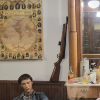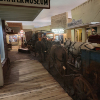Only war relic I own is what my grandfather made in France in 1918 with the AEF, as a carpenter wit the 333rd Engineers. It'[s a fired Mauser case with a pulled bullet, carefully sliced almost in two, and another peice of brass hammered flat and cut to resemble a Saracen sword, put in the bullet to make a letter opener. I offered to donate it to a museum once, but without papers, (really, for this little thing), they refused.
View attachment 1161273
My Uncle Art was a medic in Bastonge - it broke his mind.
My stepfather was a T/Sgt radio operator on a C47 during the Normandy invasion. All i have from his is his graduation "yearbook" from radio operators school and his 1946 History of WWI book the Army gave him.
It was mentioned earlier in this thread about "oddly placed memorial guns"...how about this gem at the East Texas Oil Museum in Kilgore, TX? Mind you, this was a display meant to be at the time of the big oil boom in the early 1930s, the Daisy Bradford, (which is still pumping oil today) oil boom.
View attachment 1161274
That's right, a Reising. I did call the museum after I saw it in my photos and told them that they probably needed to check the legality of that item just sitting out in a barbershop display...they had no CLUE. BTW, great little museum, highly recommend it if you are in the area.









